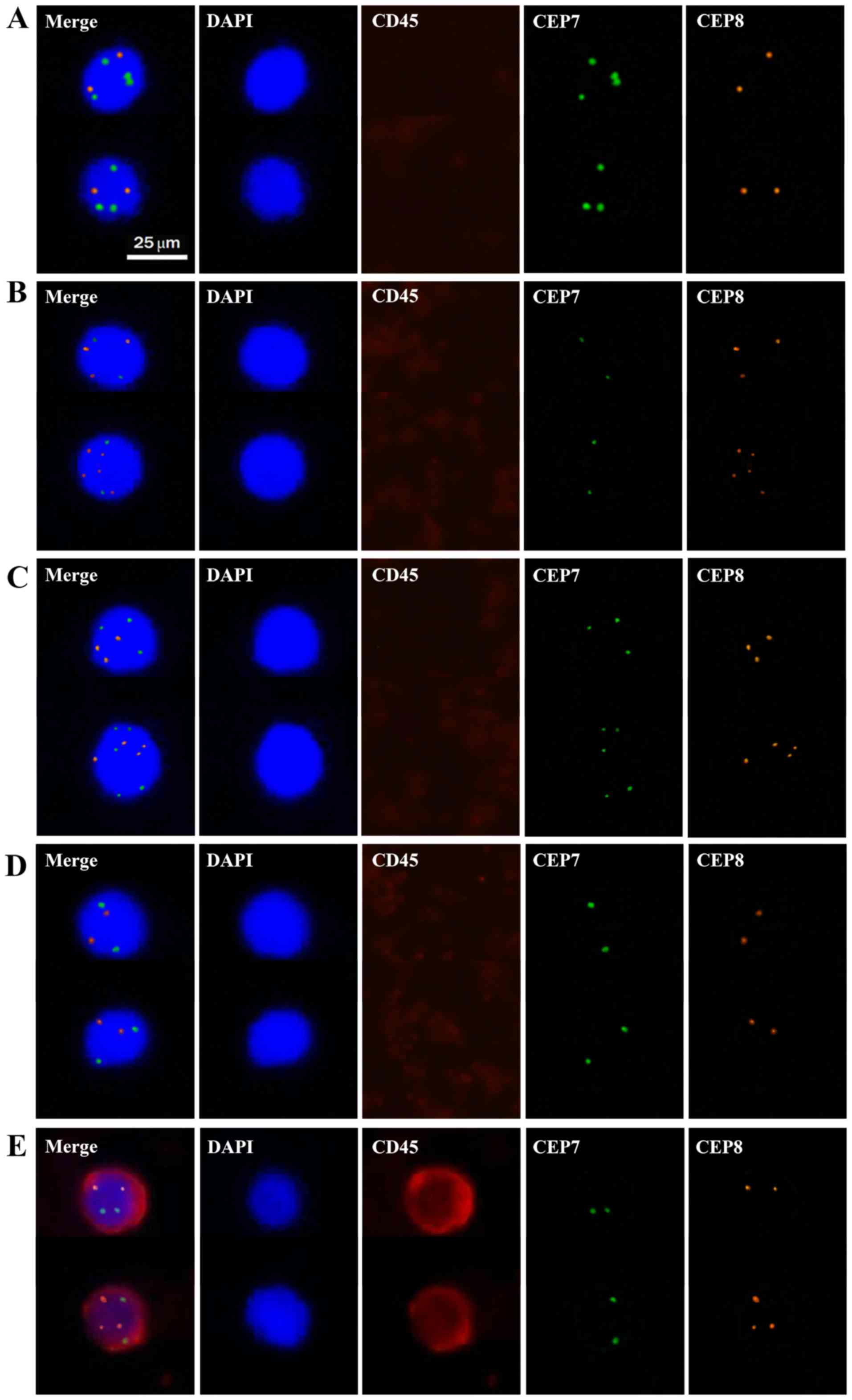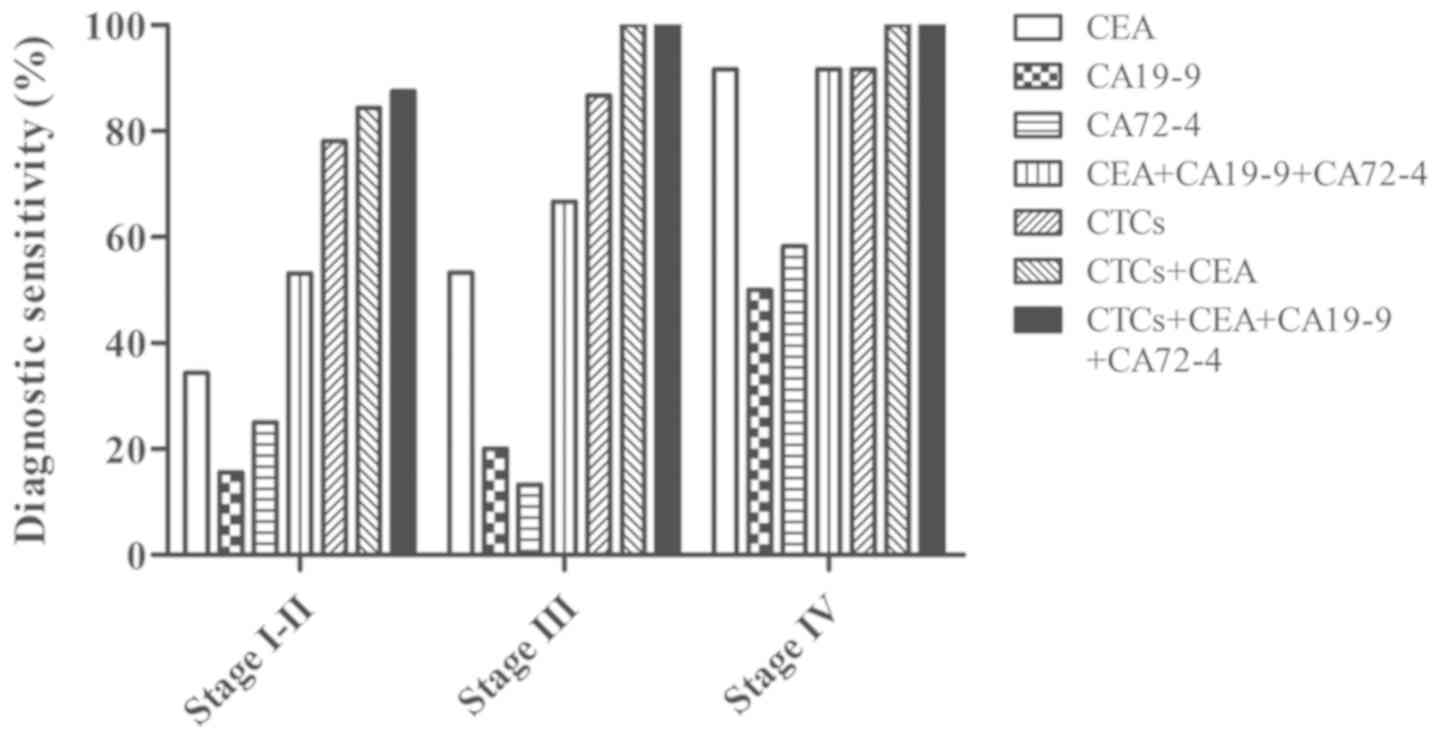|
1
|
Ferlay J, Soerjomataram I, Dikshit R, Eser
S, Mathers C, Rebelo M, Parkin DM, Forman D and Bray F: Cancer
incidence and mortality worldwide: Sources, methods and major
patterns in GLOBOCAN 2012. Int J Cancer. 136:E359–E386. 2015.
View Article : Google Scholar : PubMed/NCBI
|
|
2
|
Siegel RL, Miller KD and Jemal A: Cancer
statistics, 2018. CA Cancer J Clin. 68:7–30. 2018. View Article : Google Scholar : PubMed/NCBI
|
|
3
|
Kekelidze M, D'Errico L, Pansini M,
Tyndall A and Hohmann J: Colorectal cancer: Current imaging methods
and future perspectives for the diagnosis, staging and therapeutic
response evaluation. World J Gastroenterol. 19:8502–8514. 2013.
View Article : Google Scholar : PubMed/NCBI
|
|
4
|
Ponz de Leon M and Di Gregorio C:
Pathology of colorectal cance. Dig Liver Dis. 33:372–388. 2001.
View Article : Google Scholar : PubMed/NCBI
|
|
5
|
Shah R, Jones E, Vidart V, Kuppen PJ,
Conti JA and Francis NK: Biomarkers for early detection of
colorectal cancer and polyps: Systematic review. Cancer Epidemiol
Biomarkers Prev. 23:1712–1728. 2014. View Article : Google Scholar : PubMed/NCBI
|
|
6
|
Ryuk JP, Choi GS, Park JS, Kim HJ, Park
SY, Yoon GS, Jun SH and Kwon YC: Predictive factors and the
prognosis of recurrence of colorectal cancer within 2 years after
curative resection. Ann Surg Treat Res. 86:143–151. 2014.
View Article : Google Scholar : PubMed/NCBI
|
|
7
|
Masuda T, Hayashi N, Iguchi T, Ito S,
Eguchi H and Mimori K: Clinical and biological significance of
circulating tumor cells in cancer. Mol Oncol. 10:408–417. 2016.
View Article : Google Scholar : PubMed/NCBI
|
|
8
|
Gkountela S, Castro-Giner F, Szczerba BM,
Vetter M, Landin J, Scherrer R, Krol I, Scheidmann MC, Beisel C,
Stirnimann CU, et al: Circulating tumor cell clustering shapes DNA
methylation to enable metastasis seeding. Cell. 176:98–112.e14.
2019. View Article : Google Scholar : PubMed/NCBI
|
|
9
|
Massague J and Obenauf AC: Metastatic
colonization by circulating tumour cells. Nature. 529:298–306.
2016. View Article : Google Scholar : PubMed/NCBI
|
|
10
|
Bork U, Rahbari NN, Schölch S, Reissfelder
C, Kahlert C, Büchler MW, Weitz J and Koch M: Circulating tumour
cells and outcome in non-metastatic colorectal cancer: A
prospective study. Br J Cancer. 112:1306–1313. 2015. View Article : Google Scholar : PubMed/NCBI
|
|
11
|
Cohen SJ, Punt CJA, Iannotti N, Saidman
BH, Sabbath KD, Gabrail NY, Picus J, Morse MA, Mitchell E, Miller
MC, et al: Prognostic significance of circulating tumor cells in
patients with metastatic colorectal cancer. Ann Oncol.
20:1223–1229. 2009. View Article : Google Scholar : PubMed/NCBI
|
|
12
|
Krebs MG, Metcalf RL, Carter L, Brady G,
Blackhall FH and Dive C: Molecular analysis of circulating tumour
cells-biology and biomarkers. Nat Rev Clin Oncol. 11:129–144. 2014.
View Article : Google Scholar : PubMed/NCBI
|
|
13
|
Yu M, Bardia A, Wittner BS, Stott SL, Smas
ME, Ting DT, Isakoff SJ, Ciciliano JC, Wells MN, Shah AM, et al:
Circulating breast tumor cells exhibit dynamic changes in
epithelial and mesenchymal composition. Science. 339:580–584. 2013.
View Article : Google Scholar : PubMed/NCBI
|
|
14
|
Zhang L, Zhao M and He S: Study on the
clinical significance of detection of Cyttel circulating tumor
cells in peripheral blood of patients with gastric cancer. J Clin
Exp Med. 7:772–774. 2018.
|
|
15
|
Rajagopalan H: Aneuploidy and cancer.
Nature. 432:338–341. 2004. View Article : Google Scholar : PubMed/NCBI
|
|
16
|
Sayagués JM, Abad MM, Melchor HB,
Gutiérrez ML, González-González M, Jensen E, Bengoechea O, Fonseca
E, Orfao A and Muñoz-Bellvis L: Intratumoural cytogenetic
heterogeneity of sporadic colorectal carcinomas suggests several
pathways to liver metastasis. J Pathol. 221:308–319. 2010.
View Article : Google Scholar : PubMed/NCBI
|
|
17
|
Provenzale D, Gupta S, Ahnen DJ, Markowitz
AJ, Chung DC, Mayer RJ, Regenbogen SE, Blanco AM, Bray T, Cooper G,
et al: NCCN guidelines insights: Colorectal cancer screening,
Version 1.2018. J Natl Compr Canc Netw. 16:939–949. 2018.
View Article : Google Scholar : PubMed/NCBI
|
|
18
|
Yang Y, Li J, Jin L, Wang D, Zhang J, Wang
J, Zhao X, Wu G, Yao H and Zhang Z: Independent correlation between
Ki67 index and circulating tumor cells in the diagnosis of
colorectal cancer. Anticancer Res. 37:4693–4700. 2017.PubMed/NCBI
|
|
19
|
Gorges TM, Stein A, Quidde J, Hauch S,
Röck K, Riethdorf S, Joosse SA and Pantel K: Improved detection of
circulating tumor cells in metastatic colorectal cancer by the
combination of the CellSearch® system and the
AdnaTest®. PLoS One. 11:e1551262016. View Article : Google Scholar
|
|
20
|
Chen F, Wang S, Fang Y, Zheng L, Zhi X,
Cheng B, Chen Y, Zhang C, Shi D, Song H, et al: Feasibility of a
novel one-stop ISET device to capture CTCs and its clinical
application. Oncotarget. 8:3029–3041. 2017.PubMed/NCBI
|
|
21
|
Chen CJ, Sung WW, Chen HC, Chern JY, Hsu
TH, Min Lin Y, Lin SH, Peck K and Yeh TK: Early assessment of
colorectal cancer by quantifying circulating tumor cells in
peripheral blood: ECT2 in diagnosis of colorectal cancer. Int J Mol
Sci. 18:7432017. View Article : Google Scholar
|
|
22
|
Chen YY and Xu GB: Effect of circulating
tumor cells combined with negative enrichment and CD45-FISH
identification in diagnosis, therapy monitoring and prognosis of
primary lung cancer. Med Oncol. 31:2402014. View Article : Google Scholar : PubMed/NCBI
|
|
23
|
Ning N, Zhan T, Zhang Y, Chen Q, Feng F,
Yang Z, Liu Z, Xu D, Wang F, Guo Y, et al: Improvement of specific
detection of circulating tumor cells using combined CD45 staining
and fluorescence in situ hybridization. Clin Chim Acta. 433:69–75.
2014. View Article : Google Scholar : PubMed/NCBI
|
|
24
|
Sun B, Liu H, Wang S, Xiang J and Liu X:
Prognostic impact of circulating tumor cells in patients with
ampullary cancer. J Cell Physiol. 233:5014–5022. 2018. View Article : Google Scholar : PubMed/NCBI
|
|
25
|
Miller MC, Doyle GV and Terstappen LW:
Significance of circulating tumor cells detected by the CellSearch
system in patients with metastatic breast, colorectal and prostate
cancer. J Oncol. 2010:6174212010. View Article : Google Scholar : PubMed/NCBI
|
|
26
|
Ilie M, Hofman V, Long-Mira E, et al:
Clinical and pathological characteristics of CTC-positive COPD
patients). PLoS One. 9:e1115972014. View Article : Google Scholar : PubMed/NCBI
|
|
27
|
Meyerhardt JA, Mangu PB, Flynn PJ, Korde
L, Loprinzi CL, Minsky BD, Petrelli NJ, Ryan K, Schrag DH, Wong SL,
et al: Follow-up care, surveillance protocol, and secondary
prevention measures for survivors of colorectal cancer: American
Society of Clinical Oncology clinical practice guideline
endorsement. J Clin Oncol. 31:4465–4470. 2013. View Article : Google Scholar : PubMed/NCBI
|
|
28
|
Abe S, Kawai K, Ishihara S, Nozawa H, Hata
K, Kiyomatsu T, Tanaka T and Watanabe T: Prognostic impact of
carcinoembryonic antigen and carbohydrate antigen 19-9 in stage IV
colorectal cancer patients after R0 resection. J Surg Res.
205:384–392. 2016. View Article : Google Scholar : PubMed/NCBI
|
|
29
|
Li Q, Dai W, Li Y, Xu Y, Li X and Cai S:
Nomograms for predicting the prognostic value of serological tumor
biomarkers in colorectal cancer patients after radical resection.
Sci Rep. 7:463452017. View Article : Google Scholar : PubMed/NCBI
|
|
30
|
Gao Y, Wang J, Zhou Y, Sheng S, Qian SY
and Huo X: Evaluation of serum CEA, CA19-9, CA72-4, CA125 and
ferritin as diagnostic markers and factors of clinical parameters
for colorectal cancer. Sci Rep. 8:27322018. View Article : Google Scholar : PubMed/NCBI
|
|
31
|
Davoli T, Uno H, Wooten EC and Elledge SJ:
Tumor aneuploidy correlates with markers of immune evasion and with
reduced response to immunotherapy. Science. 355(pii): eaaf83992017.
View Article : Google Scholar : PubMed/NCBI
|
|
32
|
Papazachariou I, Tsiambas E, Koliopoulou
A, Tsounis D, Manaios M, Fotiades PP, Karameris A and Patsouris E:
Chromosomes 7, 16 numerical aberrations are poor prognostic factors
in colorectal adenocarcinoma: A tissue microarray analysis. Basic
App Pathol. 1:125–130. 2008. View Article : Google Scholar
|












